Collection of materials relating to neuro-ophthalmology as part of the Neuro-Ophthalmology Virtual Education Library.
NOVEL: https://novel.utah.edu/
TO
- NOVEL966
Filters: Collection: "ehsl_novel_novel"
| Title | Creator | Description | Subject | ||
|---|---|---|---|---|---|
| 51 |
 |
Intracranial Hemorrhage: Classification and Mechanisms | Victoria S. Pelak, MD | Intracranial hemorrhages can be life-threatening events. Classification of hemorrhages depends on the anatomical location, which also determines the associated risk factors for the hemorrhage. Descriptions of each type of hemorrhage and important aspects of the pathophysiology and risk factors are p... | Intracranial Hemorrhage |
| 52 |
 |
Patient Portal: Pituitary Adenoma | Nagham Al-Zubidi, MD | The pituitary gland is a pea-sized gland that sits underneath the base of the brain. It produces and releases many hormones. These hormones control your metabolism, stress level, growth, ovulation and menstruation in women, sperm and testosterone production in men, milk production, and urine product... | Pituitary Adenoma; Pituitary Tumor |
| 53 |
 |
Chorioretinal Coloboma | Kirstyn Taylor; Drew Scoles, MD | Coloboma is a term used to describe defects seen in various ocular structures due to incomplete embryologic development. Fundus coloboma specifically is due to failure of the embryonal fissure to close, which typically occurs by 5-7 weeks gestation. Posterior colobomas, involving the retina, choroid... | Chorioretinal; Coloboma; Optic Nerve |
| 54 |
 |
Interpreting Ocular Fundus Photographs: A Brief Guide | Gabriele Berman; Sachin Kedar; Nancy J. Newman; Valerie Biousse | This is a brief guide to the interpretation of the ocular fundus photograph. In this presentation we will describe the structures that comprise the normal ocular fundus followed the abnormalities that can be detected on fundus photographs. By the end of the presentation, learners should be able to d... | Fundus Photograph; Glaucoma; Papilledema; Retinal Detachment |
| 55 |
 |
Raymond Cestan Syndrome | Srujay Pandiri; Sean Gratton | This is a brief narrated powerpoint that explains the clinical presentation of Raymond Cestan Syndrome. This is a rare brainstem stroke syndrome that presents with ipsilateral internuclear ophthalmoplegia and contralateral hemiparesis as well as other features. It is sometimes referred to as upper d... | Brainstem Stroke Syndromes; Internuclear Ophthalmoplegia; Pons |
| 56 |
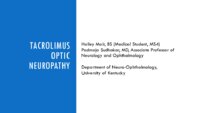 |
Tacrolimus Optic Neuropathy | Hailey Mair, BS; Padmaja Sudhakar, MD | This PowerPoint slide deck will describe tacrolimus optic neuropathy which is a very rare form of optic neuropathy but remains a potential issue in many patients that receive this drug. | Optic Neuropathy; Tacrolimus; Tacrolimus Associated Visual Loss |
| 57 |
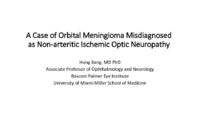 |
A Case of Orbital Meningioma Misdiagnosed as Non-arthritic Ischemic Optic Neuropathy | Hong Jiang, MD, PhD | A 62-year-old woman with hypertension, dyslipidemia, and mild cognitive impairment presented for a second opinion of her left eye visual loss for three months. She initially noticed a black spot in the lower visual field of her left eye and sought care from her local ophthalmologist. At that time, s... | Compressive Optic Neuropathy, Orbit MRI; Orbital Meningioma |
| 58 |
 |
Vergence Eye Movements | Yu Hsin Chen; Amanda Dean Henderson, MD | Vergence (e.g. convergence and divergence), a class of eye movements that rotates the eyes in opposite directions (disjunctive), serves to hold image on the fovea of both eyes in order to obtain a single, clear image. This presentation overviews the neurology and examinations of vergence response, w... | Convergence; Convergence Insufficiency; Convergence Spasm; Divergence; Divergence Insufficiency |
| 59 |
 |
Intracerebral Hemorrhage: Classification, Mechanisms, and Principles of Management | William Hills | Intracerebral hemorrhage accounts for approximately 10% of the 795,000 strokes that occur each year in the United States. Mortality is as high as 50% within 30 days of occurrence. There are several types of intracerebral hemorrhages based on inter-cranial location and mechanism. Early aggressive tre... | Epidural Hemorrhage; Intracranial Hemorrhage Management; Intraparenchymal Hemorrhage; Subarachnoid Hemorrhage; Subdural Hemorrhage |
| 60 |
 |
Retinal Venous Occlusive Disease | Ali Alkhabbaz; James Brian Davis; Amanda Dean Henderson | Retinal venous occlusion (RVO) includes central retinal vein occlusion (CRVO), hemi-central retinal vein occlusion (HCRVO), and branch retinal vein occlusion (BRVO). The most important risk factor for RVO is hypertension, but other risk systemic factors include advanced age and cardiovascular diseas... | Branch Retinal Vein; BRVO; Central Retinal Vein; CRVO; HCRVO; Retinal Venous Occlusion |
| 61 |
 |
Retinal Artery Occlusive Disease | Ali Alkhabbaz, MD; James Brian Davis; Amanda Dean Henderson, MD | Retinal arterial occlusion includes ophthalmic artery occlusion (OAO), central retinal artery occlusion (CRAO), branch retinal arteriolar occlusion (BRAO), from proximal to distal. These can occur with or without retinal ischemia and may be permanent or transient. There are 4 subtypes of CRAO: non-a... | Branch Retinal Arteriolar Occlusion; Central Retinal Artery Occlusion; Giant Cell Arteritis; Ophthalmic Artery Occlusion |
| 62 |
 |
High Yield Secondary Headaches | Kathleen B. Digre | Lecture and case reports relating to secondary headaches. | Primary Headache; Secondary Headache |
| 63 |
 |
Methanol Toxicity | Daniel Lovasz; James Brian Davis; Amanda Dean Henderson, MD | Methanol toxicity can be very dangerous with high morbidity and mortality rates, and outcomes typically worsen with increasing acidemia, hyperglycemia, or acute kidney injury. Delayed treatment can result in irreversible injury, such as vision loss, or even death. The harmful effects of methanol com... | Acidosis; Fomepizole; Formic Acid; Methanol Toxicity; Toxic Optic Neuropathy |
| 64 |
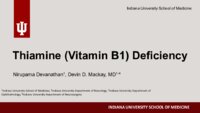 |
Thiamine (Vitamin B1) Deficiency (Presentation) | Nirupama Devanathan; Devin D. Mackay, MD | Overview of thiamine deficiency and its neuro-ophthalmic manifestations with an illustrative case example and discussion of clinical presentation, relevant biochemistry, testing, risk factors, and treatment. Corresponding Video: https://collections.lib.utah.edu/details?id=2297569 | Thiamine; Upbeat Nystagmus; Nutritional Optic neuropathy; Wernicke Encephalopathy |
| 65 |
 |
Therapeutics for Tuberous Sclerosis | Daniel Lovasz; Amanda Henderson, MD | Tuberous Sclerosis Complex (TSC) is a disease characterized by abnormal hamartomas and benign neoplasms in multiple organs. The diagnosis is made by the presence of 2 major features, or 1 major feature accompanied by 2 minor features. These features include various growths in different parts of the ... | Tuberous Sclerosis; Therapeutics; Everolimus; Sirolimus; Hamartomas; mTOR |
| 66 |
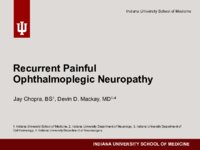 |
Recurrent Painful Ophthalmoplegic Neuropathy | Jay Chopra, BS; Devin D. Mackay, MD | Overview of recurrent painful ophthalmoplegic neuropathy with an illustrative case example and discussion of clinical presentation, possible mechanisms, and treatment. | Recurrent Painful Ophthalmoplegic Neuropathy; RPON; Ophthalmoplegic Migraine; Ophthalmoparesis; Painful Cranial Nerve Palsy |
| 67 |
 |
Natural Language Processing in Neuro-Ophthalmology | Areeba Abid, BS; Sachin Kedar, MD | This video provides an overview of natural language processing (NLP) techniques, applications, and limitations in neuro-ophthalmology. NLP, a branch of artificial intelligence, enables computers to understand and analyze human language. This video discusses three types of NLP techniques: sentiment a... | Artificial Intelligence; Machine Learning; Natural Language Processing; Word Prediction; Word Embeddings; Sentiment Analysis |
| 68 |
 |
Thiamine (Vitamin B1) Deficiency (Video) | Nirupama Devanathan; Devin D. Mackay, MD | 33-year-old female who initially presented with heat stroke that was thought to provoke cyclical vomiting over the course of 6 weeks, perpetuated by anxiety, resulting in a 15- pound weight loss. She presented to the ED with bilateral vision loss, bilateral lower extremity weakness and vertical nyst... | Thiamine; Upbeat Nystagmus; Nutritional Optic Neuropathy; Wernicke Encephalopathy |
| 69 |
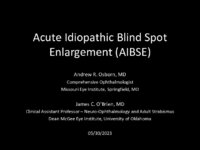 |
Acute Idiopathic Blind Spot Enlargement (AIBSE): Images | Andrew R. Osborn, MD; James C. O'Brien, MD | We present a single case of Acute Idiopathic Blind Spot Enlargement (AIBSE) in a young female patient, including her clinical course and relevant imaging studies. Her case description is followed by a brief discussion surrounding the current understanding of this rare entity. Associated Case Report:... | Acute Idiopathic Blind Spot Enlargement (AIBSE); Outer Retinopathy |
| 70 |
 |
Acute Idiopathic Blind Spot Enlargement (AIBSE): Case Report | Andrew R. Osborn, MD; James C. O'Brien, MD | We present a single case of Acute Idiopathic Blind Spot Enlargement (AIBSE) in a young female patient, including her clinical course and relevant imaging studies. Her case description is followed by a brief discussion surrounding the current understanding of this rare entity. Associated Images: http... | Acute Idiopathic Blind Spot Enlargement (AIBSE); Outer Retinopathy |
| 71 |
 |
Melanoma Associated Retinopathy (MAR) | James O'Brien, MD; Brian Firestone, MD | Grand rounds PowerPoint presentation slides regarding a case of MAR diagnosed at our institution. | Paraneoplastic Syndrome; Melanoma; Retinopathy |
| 72 |
 |
Treatment Outcomes of Ocular Manifestations in Wernicke's Encephalopathy: Images | Whitney Stuard Sambhariya PhD; Melanie Truong-Le, DO, OD | The case of a 28- year-old woman with a past medical history of gastric sleeve who was reported to have blurry vision and presented to neuro-ophthalmology with double vision. On examination the patient had bilateral abducens palsy, alternating upbeat and downbeat nystagmus with a torsional component... | Wernicke's Encephalopathy; Ocular manifestations; Neuro-ophthalmology; Sbducens palsy; Nystagmus; Double vision; Blurry vision |
| 73 |
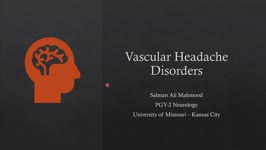 |
Vascular Headache Disorders | Salman Ali Mahmood, MD; Sean Gratton, MD | This is a PowerPoint with embedded audio presenting a detailed summary of the evaluation and management of an important cause of secondary headaches: vascular headache disorders. Topics covered include intracranial hemorrhage, arterial dissection, giant cell arteritis, cerebral venous sinus thrombos... | Vascular Headache Disorders; Epidural Hematoma; Subdural Hematoma; Subarachnoid Hemorrhage; Intracranial Hemorrhage; Arterial Dissection; Giant Cell Arteritis; Cerebral Venous Sinus Thrombosis; Pituitary Apoplexy |
| 74 |
 |
Treatment Outcomes of Ocular Manifestations in Wernicke's Encephalopathy: Video | Whitney Stuard Sambhariya, PhD, Medical Student; Melanie Truong-Le, DO, OD | The case of a 28- year-old woman with a past medical history of gastric sleeve who was reported to have blurry vision and presented to neuro-ophthalmology with double vision. On examination the patient had bilateral abducens palsy, alternating upbeat and downbeat nystagmus with a torsional component... | Wernicke's Encephalopathy; Ocular Manifestations; Neuro-ophthalmology; Sbducens Palsy; Nystagmus; Double Vision; Blurry Vision |
| 75 |
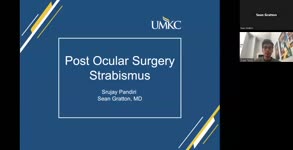 |
A Brief Introduction to Post-Ocular Surgery Strabismus | Srujay Pandiri, Medical Student | This is a short narrated Powerpoint that introduces concepts important to post-ocular surgery strabismus. It highlights the connection between common surgeries include cataract surgery, scleral buckle surgery, refractive surgery, among others. | Diplopia; Strabismus; Post-ocular Surgery Strabismus |
